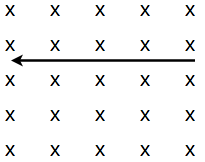All MCAT Physical Resources
Example Questions
Example Question #2 : Electricity And Magnetism
An electron is traveling at constant velocity directed to the the left through a magnetic field directed into the page as shown below.
Which way would the force vector on the electron due to the magnetic field be directed?
Out of the page
Towards the right of the page
Towards the bottom of the page
Towards the top of the page
Towards the top of the page
When finding the direction of the force on a POSITIVELY charged particle due to a magnetic field, we can use the right hand rule. Holding your thumb perpendicular to the rest of your fingers (as if motioning to stop), orient your fingers parallel to the lines of the magnetic field, and your thumb with the velocity vector of the charge. For a positive charge, the force would be oriented directly out of the palm; HOWEVER, the charge of an electron is negative and therefore the force will be applied in the opposite direction. This would mean that the force would be coming directly out of the backside of your hand (in this case, towards the top of the page) using the right hand rule.
Example Question #3 : Magnetism And Electromagnetism
A charged particle enters a uniform magnetic field, with velocity v perpendicular to the field, and moves in a circular path of radius R. If the particle's mass were doubled, the radius would become __________.
2R
R/4
4R
R
R/2
2R
A charged particle's motion in a uniform magnetic field is described by R = mv/qB, so the radius of the particle's path is proportional to its mass. Thus if mass is doubled, radius is also doubled.
Example Question #1 : Magnetism And Electromagnetism
An electron is moving at a constant velocity due east. It travels from a region of zero magnetic field into a uniform magnetic field of nonzero magnitude and unknown direction. Which of the following could not describe the electron's motion after entering the field?
It continues traveling east at the same velocity
It continues traveling east, but at a greater velocity
Its path begins curving to the north
It travels in a helical path
Its path begins curving to the south
It continues traveling east, but at a greater velocity
A magnetic force can accelerate a charged particle by changing the direction of its velocity, but cannot change the magnitude of velocity.
If the magnetic field has any components perpendicular to the particle's initial velocity, the particle will experience a force according to the equation:
This force is generated perpendicular to the particle's path and will cause a change in the direction of the particle's velocity. If the magnetic field is parallel to the initial velocity, the particle will experience no magnetic force, and its path will remain unchanged. It is not possible for the particle to accelerate in the magnetic field without changing direction.
Example Question #3 : Gre Subject Test: Physics
What is the magnitude of force on a 


The equation for finding the force on a charge in a magnetic field is
F = qvBsinθ
Where q is charge in coulombs, v is the velocity of the charge, and B is the strength of the magnetic field in Teslas. Since the charge is moving perpendicular to the magnetic field, sinθ =1. Therefore we solve for force by plugging in the values and multiplying.
Example Question #11 : Electricity And Magnetism
In a current-carrying wire, which of the following expressions best relates charge, current, velocity and the length of the wire?
Assume 
The force of a charge in a magnetic field is given by the equation 
Additionally, the force on a current-carrying carrying wire in a magnetic field is given by the equation 
Because we assume the angle to be 90o , we can set the two force equations equal to each other, and derive the equation 
By manipulating the variables, we can generate the equation 
Example Question #11 : Electricity And Magnetism

The particle depicted above on the left has a charge of 

It will move away from the observer
It will move downwards
It will slow to a halt
It will move toward the observer
It will move upwards
It will move away from the observer
To determine the direction the charge will accelerate, use the right hand rule for magnetic force. To begin, hold out your hand and give a "thumb up," now rotate your wrist 
Certified Tutor
Certified Tutor
All MCAT Physical Resources














